To celebrate International Apithology Day 2017 there was a special event. This was an invited preview of the art exhibit titled ‘The Opposite of War (is not Peace)’.
The history of this exhibit goes back to an art project from an inquiry in December 2015. The question asked was: ‘What would an apithological approach to world peace look like?’ . The result was a series of art works, an art installation, a published book, a formal academic journal article, a two day masterclass seminar – plus a series of recorded ‘peace talks’. All of these looked at a practical approach to the topic of envisaging a generative approaching of world peace.
The artwork in ‘The Opposite of War’ series itself consists of 13 digital prints, stark in their simplicity – and confronting in their complexity. They are best viewed as a complete installation, billboard-sized, where the ‘all at once’ effect of a reversing of our commonly held beliefs about peace and war can be seen as one composite canvas.

Peace.Plates – willvarey (2017)
Each work in the series consists of three parts: a single word describing a form of violence that causes the conflicts leading to war, its visual juxtaposition by the named conflict’s apithological counterpart as ‘a peace-fulfilling’ humanity value, and the title plate of the work itself, which has the familiar statement of the default counter-balance we usually adopt for each humanity conflict.
There is a ‘trilogy of disparity’ in these three associations – one that prompts and challenges us to form different peace conceptions.
The title piece of the work comes from a different horizon of understanding. The counterpart that is the apithological presence, that makes war unnecessary, is not peace, but is in fact trustworthiness. This opens the path to a different way to think about the form of humanity’s needs for the presences enabling a world of peace. The invite into this frame is offered by the quote:
“The commencement of war is not the outbreak of hostilities, it is the breakdown of trustworthiness.” – Will Varey

Title Plate: The Opposite of War (is not Peace)
When we consider the graphic extremes of war, this form of peace-ful art is both disarming and disorientating, offering a zen-like reversing of what it means to be confronted – or even to be confrontational. What the canvas presents most to us, is the visualisation of our own associative mind. These works together represent a dozen distinct and related structures of human conflict and enablement. Seeing them presented together, changes the holding of our specialist discourses. The experience is like seeing for the first time how ‘a humanity’ would ask the peace question directly.
On seeing the work in a gallery space the parallel that comes to mind is the first presentation of the full series of ‘Campbell’s Soup Cans’ (1962) by Andy Warhol in the Ferus Gallery in LA. The curator after sitting with those works bought back the few copies that sold during the exhibition to preserve the set. Their original $3,200 (collected) price-tag now would hold a value in the tens of millions.
 Warhol (1962) – Original Display
Warhol (1962) – Original Display
The installation ‘The Opposite of War (is not Peace)‘ not only says something, it does something – putting into one frame all of our peace and war discourses and potential framings. There is a significance here that is so understated as to be loud in its revelation.
Memetic Opposites
There are a number of other memes and proposals for the ‘opposite to war’. These include (drawing from a range of writers):
‘creation‘, ‘creativity‘, ‘procreation’, ‘development‘, ‘synergy’, ‘culture’, ‘expression‘, ‘accord’, ‘order‘ ‘gratitude‘, ‘brotherhood‘, ‘communion‘, ‘civilisation‘, ‘progression‘, hospitality’, ‘society’, ‘humanity‘ and ‘non-war’.
While different in concept, almost all are framed around the general idea that as war involves mutual destruction, its opposite must be some form of mutuality in production. The question asked is how might we instead of ‘waging war’ engage equally in ‘waging peace‘ ? Essentially, by artistic production, can we hope to equalise the ledger entries, for our wilful destructions?
This idea has two subtle problems. One is that the engine of war is uncharacteristically productive, both in terms of physical machines and human effort (e.g. industrial production figures in Europe during WWI’s lead up and the industrialisation of the USA following its entrance to WWII). To respond to a conflict, is to become, intensely productive.
We naturally sense that war’s opposite is more than only making inspiring art, there being such a different originating impulse to their specific creations and innovations. The machines for peace can not remedy the machinations of war, they can only be their own expression. We later discover by inquiry that the antipathy of creativity, is not hostility, its stagnation. Human ingenuity, operates in war and peace times equally, just differently.
The second is that setting up destruction|production as the simile for the war|peace dichotomy proposes a set of neutralisations, where each element is necessary to form some type of synthesis of opposites in a normative equalisation of acceptable stability. In a sense, war is seen as the antidote to peace. This framing of the outcomes of opposites negates the possibility for a ‘peace that is beyond war’ and a more generative ‘apithology’ envisaging.
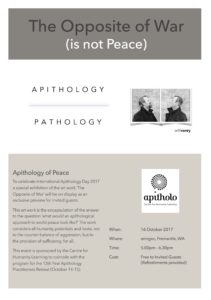
Clarity comes from seeing that the word ‘war’ in this context means the physical actions of war, involving hostility, brutality and unexpected attacks on personal safety. In looking for war’s opposite, it is more its antonym in concept that is inquired into, rather than the foundational need for an absence of its presence as undesired actions.
The informed approach to an inquiry into peace, that is more than war’s absence, sees a mirroring between “negative peace” (ie the absence of war) and a “positive peace” – being defined as ‘the establishment of life-affirming and life enhancing values and structures’ (Barash, 2010).
This proposition establishes that negative peace is a ‘necessary but not sufficient condition for positive peace‘. This distinction sees that ‘peace’ has more than one horizon of conception. The discipline of apithology begins in reliance on what is necessary for conflict cessation, but does what is sufficient for the generative conditions for enablement beyond mere negative conceptions.
Approaching Apithology
For those not yet familiar with apithology, this field is the research discipline that looks at the causes of generative health in living systems. It’s a systems science, so rather than promoting reductionist approaches to presenting problems, it begins from a different horizon of inquiry, using the humanity-system as its a priori object of ontological reference.
The premise is simple. If you are going to look for a generative state beyond remediation of an existing pathology, do not begin with closed problem/solution framings. If you are going to look at world solutions, do not begin with individual opinions and then hope to gather up the whole by many partial iterations. Also, if you are going to consider a world system, do not isolate the parts without reference to their causal relations to all others.
This is as simple as:
a) understand the question’s outcome (as to desirability),
b) begin with the whole discovered (in its totality),
c) look to the relations between all parts (and do so intricately).
(called in apithology the ‘Three Parameters’).
The implication is that use of a combined set of abductive inquiry processes leads to unexpected novel answers. We find then how the form and intention of our inquiry precedes and precludes merely hopeful deductive assumptions or speculations. The mis-guided or ill-formed dead-end hypothesis is then successfully avoided.
“They have not wanted peace at all; they have wanted to be spared war –
as though the absence of war was the same as peace.” – Dorothy Thompson
The idea of ‘world peace’ – is distinctively one that lends itself to this different form of informative framing and generative inquiry. The question then is whether our idea of humanity-caring requires this of us, definitively.
Horizonal Change
Apithology as a science is informed by the factual observation of developmental psychology that there are distinct major structures in human cognitive framings, each of which is ontologically exclusive (i.e. Wade, Kegan, Wilber, Loevinger, Commons, Fischer, Graves, et al.). These broadly defined ‘potentials’ for the humanity experience operate in a complex modern society almost like an ecological topology of concomitant ecosystems, only more so as collections of conceptions in an ecology-of-thought.
In apithology, offering opinions from one such ontological framing, without reference to all others in the thought-ecology, is seen as form of uninformed (or even ignorant) violencing. This is considered not conducive to the humanity-inclusive discourses that are enabling of humanity inquiry. The idea of framing a conversation on a solitary conception of a universal topic (ie world-peace) is not done without proper considerations.
To ignore this ethic is really just a way of setting up the opinions about the topic as a fractal demonstration of the wider humanity-scale conflict. The best that can be hoped for is an acceptance of the ‘beautiful mess’ from the imposition and opposition that follows. What we have learned in apithology praxis is that, for productive discourses in humanitarian inquiry in the 21st century, methods of greater efficacy and surety are necessary.
“Peace is not merely a distant goal that we seek,
but a means by which we arrive at that goal.” ~ Martin Luther King Jr.
Another distinguishing feature of an apithology approach to peace is that it does not start from the assumption that the speaker’s or commentator’s viewpoint is a universally held and valid worldview. While it may be accurate of that unique commentator’s view of the world and experiences, it probably does not contain (or respect or reflect) the other world-views already operating.
Proposing unacceptable solutions so that a counter-balance is required, is itself reflective of the hostile aggressions requiring re-balancing, opposition and pacifications in war torn conflicts. In curating such forums, our peace talks, may naturally become battlefields. In this sense, while acceptable to one person, any universal solution in ignorance of the totality of human valuings, is going to be unacceptable to many other’s imaginings. Our opinions on universal questions, will then be rejected, due to the limitations of our self-referencing suggestions.
So … how would apithology approach ‘world peace’ – apithologically?
Imposing Pacifications
One thing an apithology approach to world-peace would not do, is fall into the default trap of seeking to remediate a deficiency by imposing an unacceptable (or impossible) enaction on the aggressor. To do so, is just another form of violence, premised on the impossibility of any hope for our collective worthwhile existence.
In apithology, we understand that pathology is not an expression to be countered, it is an absence that arises from some lack in one form of an essential provision. Ordinarily, we attempt to counter a lack with a counter-force. If a child misbehaves, we feel we must punish the action by taking away a privilege from them. If someone steals, we remove their liberty. If a country is aggressive, we enact aggression against them. In apithology we see each symptom and its cause differently – and enact a different remedy.
The dynamics of this are too hard to explain inexpertly. It is perhaps helpful and sufficient to understand that as each structure of potential of humanity moves into a different set of existential tensions, so too does its relationship to war as a solution change.
The requirement for war remains, yet our conception of what this contains by way of acceptable violences, shifts in its envisaged horizons. An unseen effect of this is, as humanity’s values expand in their complexity, the impositions we place on others in their peace-full-ness enables and justifies for us, new forms of violence.
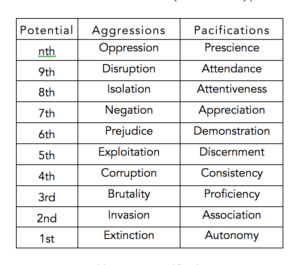
Table 1. – Varey, W. (2017) ‘The Apithology of Peace: Ten Pacifications for Peace-Fulfillment’. Aspects of Apithology, Vol. 6. No. 4, 1-7.
Essentially, to the acutely vulnerable we act for momentary rescue and survival, for the dispossessed we insist they protest invasion, for the brutalised we appeal for them to ask for mercy and compassion, to the persecuted and unjustly treated we instruct they should follow due process for redress, to the exploited and disadvantaged we propose they gain equality by negotiation, for the prejudiced against and voiceless we invite society to impose greater forgivenesses and tolerances, for the marginalised and negated we insist they call for greater attention, etc. One can easily see the inherent unfairness in such suggestions.
The discourses in this field are convoluted and heart-felt (and ultimately ineffective). In apithology the discourses envisaged are distinct and revelatory (and intimately enacted). The apithology of peace asks us to become aware of the violences we enact in our self-expression of held values, lest our attempts at peace, become the instigations of even greater and more subtle injustices.
This ethicality of a humanity-nurturing awareness, is one consideration even the kindest of protectors may feel they are entitled to ignore, given the virtue of their self-determined determinations for others. The apithology of peace discourse therefore challenges conventional forms of peace impositions, moving beyond the cessation of hostilities to the absence of the need for the causes of war systemically, holding in its framing a humanity-caring that operates centrally.
This requires of us an openness to new nuances and some novel fundamental trainings.
Peace-full Orientations
Without going into the theory of apithology and its forms of analysis, the idea of war itself is seen in apithology as a set of imbalances. This characterisation (in four orientations) sees ‘war’ as the name we give to the various forms of enduring hostility that come from the imbalance between aspirations and their application (Aspects of Apithology Vol. 1 No. 2).
For example, the hostilities leading to forms of war occur by the holding of ‘enmity‘ and ‘belligerence‘ together – where hatred and aversion manifest as aggression and destruction (pathology – p.).
By contrast, the apithology of peace comes from holding in a generative tension the ambitions and actions of ‘affinity‘ and ‘trustworthiness‘ – where associative mutuality enacts as reliance and dependability (apithology – a^).
Where one dependency is absent, there is a different orientation of direction. When we have affinity, but maintain forms of belligerence, there is a conflict of interests but a respectful cessation of violence – as seen in armistice, truce and stand-offs (anti-pathology – p+).
When we have some enmity of difference, but maintain forms of trustworthiness, there is formed limited extensions in ‘hospitality’ – as seen in tenuous trade relations and guarded rights of free passage (apathology – a_).
In this simple analysis of the dynamics of cause, apithology sees ‘peace’ and ‘war’ not as either inherent forms, or temporary states, but as the enduring resultants of ongoing tensions of presences, absence and their tenuous balances.
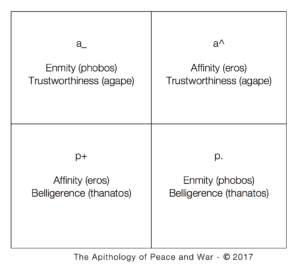
This leads the apithology practitioner to look deeper into peace discourses, to see the forms of enablement of conducive conditions and the generative provisions required, that make conflict formation – and perpetuation, inconceivable as viable humanitarian resolutions.
From this we begin to learn that the ideal of ‘world-peace’ is now simplistic and unattainable, for there are multiple human conceptions of war and peace, that are held passionately and are opposed equally.
In an apithology approach the understanding of world-peace means instead ‘a peace between self-worlds’, where in the combinations of conflicts there is an combination inherently possible for mutually enacting ‘peace-fulfillments’. It is by the apithology of humanity inquiry that we are able to glimpse this clarity, directly. This is what is meant by the maxim: “Enable all to enable all“.
Peace Fulfilment
In staying with this inquiry intimately a new insight emerges, being that in talking about peace from a generative perspective, the word that means ‘a temporary cessation of an enduring hostility’ is found to be inadequate. What we discovered in this discourse is that even the replacement of ‘peace’ with ‘peaceful’ – as the desired state for attainment, did not sufficiently hold the ‘apithology of peace’ as a concept.
Instead the phrase that came up as being more useful, was that the peace that is beyond war is known as ‘peace-fulfillment’. In apithology, because living systems are seen as continuing and also continuously growing and changing, a ‘fulfilment’ is a dynamic concept where a potential is actuated, but the enactment itself is without stasis or static attainment. The idea of ‘peace-fulfillment’ is the state that occurs when the presences of peace are put in place continuously.
In this circumstance, we find that the ‘enablement of peace-fulfillment’ means the absences that give rise to the causes of war, will never arise without the response of provision and astute enabling actions. This ‘peace-envisioned’ state means that the apithology of peace becomes us, as we become more peace-fulfilled, in us.
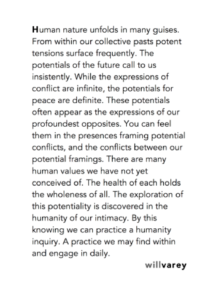
Extract: The Opposite of Peace (is not War) © 2017
Humanity Reflections
If we reflect for long enough on the aspects of peace (and war), what we find is our own humanity is reflected back to us acutely. We see in the barbarism and inconceivability of war a distancing from the humanity of our pasts, where we could not, at that time, conceive of any other just alternatives. To acknowledge our humanity is to recognise, that in the defence of what is precious and virtuous, we will defend our loves with viciousness and presumptuousness.
Only later do we see our necessary violences as unacceptable conducts, in a preference for newer and more socially-resonant violences. Because apithology invokes a view beyond the mirror of peace as war’s opposite, and sees peace as a reflection of an ongoing evolution of humanity values, which include those values we have not attained just yet, its peace discourse is more embracing of our wars for peace and our pacifications using violence.
To embrace these is to embrace our past and future humanity. For these acts of peace and war are our humanity expressions. Perhaps in conclusion, the acceptance of these asks of us an even greater forbearance … that when engaging in peace, we will do so with due humanity, humane considerations for all future potentials, and significantly lesser violences to all persons in our peaceful pacifications.

Artwork: Vestige by Rob Mullholland
Envisaged in the apithology of peace is a place in time where war becomes unknown as a necessary absence that holds a just cause for all our violences. This will be an awareness come to from within an intimacy with human needs in all potentials. This will require the active recognitions of lack, absence, or non-presence with a sense of prescience; seeing what is required, before it is expressed in unfulfilled and unmet human desires.
This envisaging may be beyond our imagining.
One excitement we do know, is in viewing the installation of ‘The Opposite of War (is not Peace)’ there is something of our humanity that looks back into us …
– and this is comfortingly confronting.
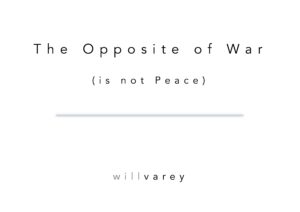
Book: Cover Page (2017)
Title: The Opposite of War (is not Peace)
Author: Will Varey (2017) ; ISBN: 9780648193005
Published by Ornithorincus Press, Melbourne.
© willvarey 2017
References:
Barash, D. P. (2010). Approaches to peace: A reader in peace studies. New York: Oxford University Press.
